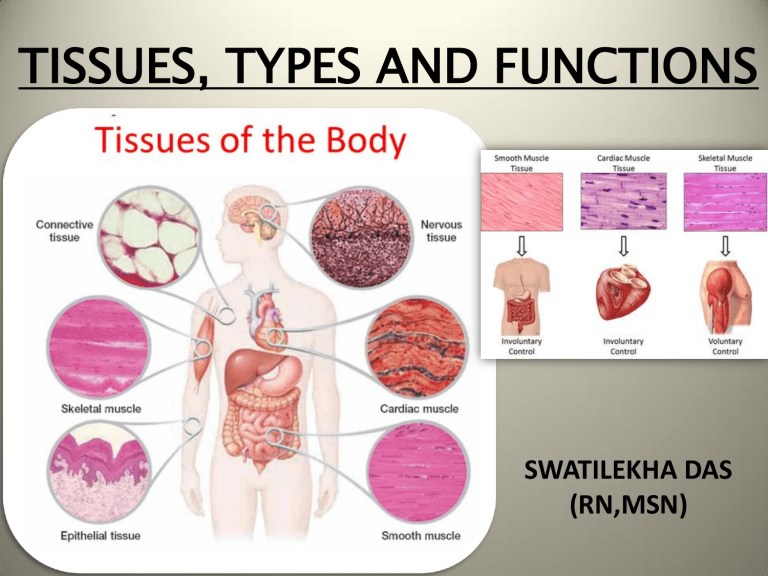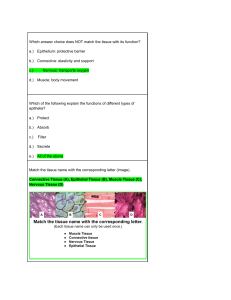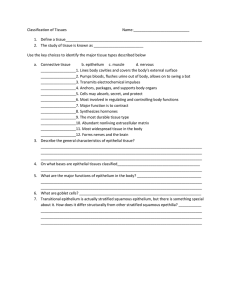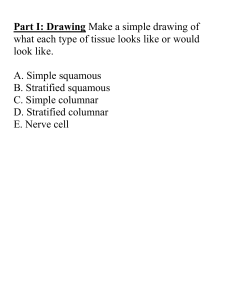
TISSUES, TYPES AND FUNCTIONS SWATILEKHA DAS (RN,MSN) TISSUES Human body is made up of four basic tissues: epithelial tissue, connective tissue, muscular tissue and nervous tissue. TISSUES Epithelial tissue A.Simple epithelium i. Squamous ii. Cuboidal iii. Columnar iv. Pseudostratified B. Stratified epithelium i. Transitional ii. Stratified squamous nonkeratinized iii. Stratified squamous keratinized Connective tissue Cells a. i. Fibroblasts ii. Fibrocytes b. Adipose /fat cells c. Plasma cells d. Mast cells e. Macrophages f. Leucocytes g. Pigment cells h. Mesenchymal cells Fibres i. Collagen fibres ii. Elastic fibres iii. Reticular fibres Muscular tissue Nervous tissue i. i. Skeletal muscles ii. Smooth muscles iii. Cardiac muscles Central nervous system ii. Peripheral nervous system iii. Autonomic nervous system EPITHELIAL TISSUE Epithelial tissue lines the external & internal surfaces of our body. It can be ectodermal, mesodermal and endodermal in origin. Function: i. Protection ii. Secretion iii. Absorption iv. Forms glands & ducts Epithelium can be simple or stratified. A. Simple Epithelium An epithelium is called as simple when all the cells rest on the basement membrane. It can be : i. Squamous epithelium- is one in which cells are flattened with nuclei raising a bulge in the cell. It allows rapid exchange of substances through it. e.g. epithelial lining of alveloi . ii. Cuboidal epithelium- is one in which cells are like a square where height of the cell is equal to the width of the cell. The nucleus is central and round. Its main function is absorption and secretion e.g. epithelial lining of follicles of thyroid gland. iii. Columnar epithelium- is the one wherein the height of the cells is greater than the width of the cells. The nuclei is basal and vertically elongated. Functions of a columnar cell are protection, secretion and absorption. e.g. epithelial lining of fallopian tubes. Cilia Single layer of column of rectangular cells Basement membrane iv. Pseudostratified epithelium- Pseudo= false, stratified= multilayered. As the name suggest there is false appearance that the epithelium is multilayered. In fact some cells are short while the others are tall but all the cells rest on basement membrane e.g. epithelial lining of trachea. B. STRATIFIED EPITHELIUM Multilayered epithelium is known as stratified epithelium. i. Transitional epithelium- this kind of epithelium lines an organ which is distensible e.g. urinary bladder. ii. Stratified squamous non- keratinized epithelium– it is a multilayered epithelium in which basal cells are columnar. E.g. epithelial lining of esophagus. iii. Stratified squamous keratinized epithelium – It is a multilayered epithelium just like Stratified squamous non- keratinized epithelium but here the top most layer is that of keratin through which water can neither be evaporated from the body as in standing in sun nor can it be absorbed into the body as while swimming e.g. epidermis of skin. CONNECTIVE TISSUE As the name suggests it connects different components of our body. It is made up of cells, fibres and matrix. Fibroblasts, fibrocytes, macrophages and adipose cells are the example of some connective tissue cells. Matrix is composed of ground substance and fibres. Functions: i. Providing support to different parts of our body. ii. Connects different components of our body. iii. It is a medium for exchange of nutrients, metabolites and oxygen between blood and cells. CELLS a. i. Fibroblasts- the cells which synthesize collagen fibres, elastic fibres and lays down matrix are know as fibroblasts. ii. Fibrocytes- when the fibroblasts mature they are known as fibrocytes. b. Adipose / fat cells- they are rounded cells but they are usually present in group, they get mutually compressed so may have variable shape. They have fat globule in their cytoplasm which pushes the nucleus to periphery giving the cell signet ring appearance. Their function is to store fat in their cytoplasm. c. Plasma cells- rounded to ovoid basophilic cells with cart wheel nucleus. They are rich in rER. Their function is to synthesize immunoglobulins. FAT CELLS PLASMA CELLS CART WHEEL NUCLEUS PLASMA CELLS d. Mast cells- they are involved in inflammatory reactions. e. Macrophages- their function is to engulf various foreign particles. f. Leucocytes- White Blood Cells are known as leucocytes. They are neutrophils, lymphocytes, eosinophils, basophils and monocytes. They have defensive action. g. Pigment cells- import brown color to the skin when they are present in epidermis. Their presence offers protection against ultraviolet rays of the sunlight. h. Mesenchymal cells- are undifferentiated cells. They can differentiate into a variety of cell types. FIBRES a. Collagen fibres- they are flexible but offer great tensile strength. They found in tendons, ligaments and all kinds connective tissues. b. Elastic fibres- they can stretch and then come back to their normal size when stretching force is relieved. They are found in ligamentum nuchae, ligamentum flava and in the wall of large arteries. c. Reticular fibres- they are special type of collagen fibres and can be seen only by special stain. They are seen in the connective tissue framework of spleen, liver lymph nodes. Connective tissue can be : A. General connective tissue: a. Loose connective tissue b. Dense connective tissue c. Mucoid tissue d. Adipose tissue B. Specialized connective tissue: this comprises of bones, cartilages an hemolymphoid tissue. a. Cartilage – Hyaline cartilage, elastic cartilage, fibrocartilage b. Bone- made up of organic & inorganic substances. c. Hemolymphoid tissue- blood & lymphatics fall in this group. MUSCULAR TISSUE There are three types of muscles namelya. Skeletal muscle- they help in locomotion e.g. biceps femoris. b. Smooth muscles- they are present in the viscera of our body e.g. muscle in the wall of stomach. c. Cardiac muscle- it is seen only in the heart. Contraction of this muscle helps in pumping of blood throughout our body. NERVOUS TISSUE It consists of central nervous system, peripheral nervous system and autonomic nervous system. It helps in sending different kinds of information to brain and bringing its responses back from brain to the effector organ. PLEASE LIKE , SHARE AND SUBSCRIBE








